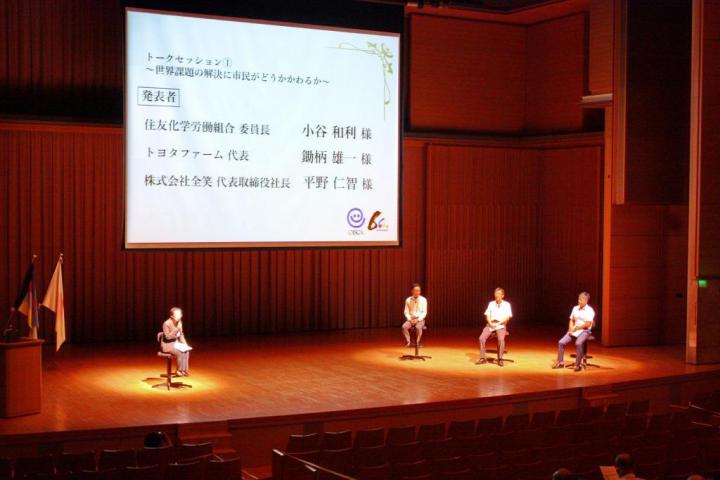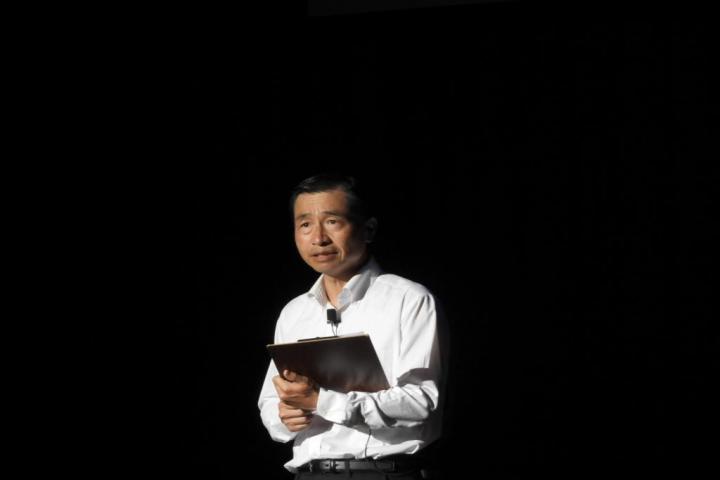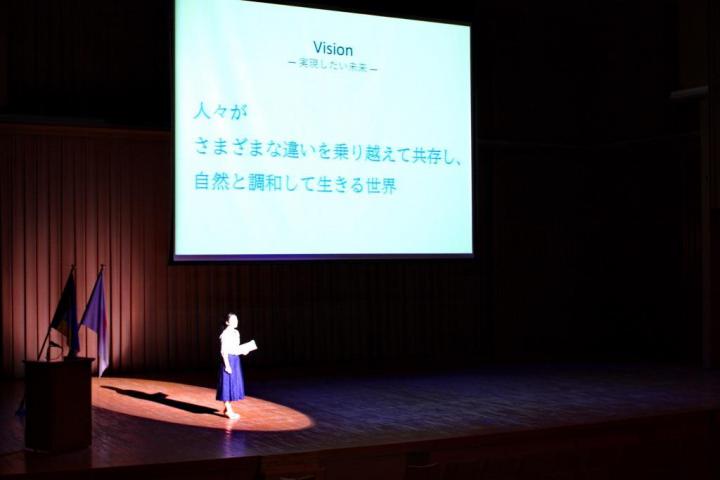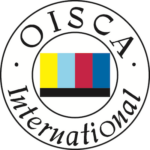
Oct 26, 2021
On October 6, OISCA held a symposium to commemorate its 60th anniversary at the Large Hall of the Arts Building, National Olympics Memorial Youth Center in Yoyogi, Tokyo. The symposium held with the title of “Be the Solution: to demonstrate ways in solving world environmental issues” was participated in by about 600 people comprising representatives from OISCA member corporations and labor unions, government officials, NGO and NPO, and individual members as well as by OISCA staff. Out of the 600 persons, a total of 200 were actually present on the spot and the remaining 400 joined online.
At the outset, a video depicting the brief history and OISCA’s activities and containing congratulatory messages from OISCA families abroad were shown.
Afterwards, the first part of the presentations on the next 10 years of OISCA started with 3 speakers, namely, Mr. Cho Hiroyuki , Director for Research and Study, International Cooperation Division, Ms. Suzuki Kazuyo, Deputy Manager, Division for Domestic Cooperation, and Mr. Morita Akira , Managing Director & Director of International Cooperation Division.
First, Mr. Cho took the floor and affirmed that OISCA would vigorously continue capacity building and environmental conservation activities in the future. He specifically mentioned the Coastal Forest Restoration Project which was launched in Miyagi Prefecture immediately after the destructive Great East Japan Earthquake Disaster in March, 2011 and the Desertification Project that is going on in the Aral Sea area, Uzbekistan.
He explained that the technical intern trainees handled by OISCA first undergo training in Japanese culture, Japanese language, manners and discipline at national training centers of respective countries and domestic training centers in Japan. In that sense, they were clearly different from those accepted by other organizations. He emphasized that OISCA is not an organization which opposes against specific environmental issues, but rather proposes constructive actions for solving the problems.
Then, Ms. Suzuki expounded the vision, mission and value of OISCA, citing the words of OISCA founder, Rev. Yonosuke Nakano. She said that OISCA brings up people who respect local inhabitants, have gratitude and live with the earth.
Mr. Morita presented on the ambitious targets that OISCA intends to push through for next 10 years from 2021 to 2030. The targets are based on two approaches: EBS (Eco-System based Solution) and BBS (Business-based Solution). He specifically mentioned that in EBS, promotion of model forestation projects over 50,000 hectares, involving children and youths in community environmental and social issues through Children’s Forest Program (CFP) for 500,000 persons, implementation of sustainable community development projects such as recycling organic farming, and promotion of sustainable agricultural training for leadership in 3 training centers in Japan for 300 persons. While in BBS, he elaborated on two approaches: partnership with the business sector and social business. Concretely, he raised the acceptance of technical intern trainees aimed at meeting the original objectives of the system beneficial to the trainees, Japanese society and countries of origin; and promotion of social businesses making full use of OISCA’s human network in Japan and abroad.
Afterwards, Ms. Nakano Etsuko , President of OISCA, made brief remarks. She said that OISCA, as with other organizations, has been in serious difficulties due to the world wide COVID-19 pandemic. But in spite of the financial and physical problems, OISCA staff with the help of member corporations, organizations and individuals as well as volunteers, are brilliantly coping with the difficult situation, and requested for continued cooperation.
Then, followed the first part of talk session I (How citizens are involved in solving world issues). There were 3 speakers: Mr.Kotani Kazutoshi , Executive Committee Chair, Sumitomo Chemical Company Labor Union, Mr. Sukigara Yuichi , Representative of TOYOTA Farm, Mr. Hirano Hirotomo , CEO, Zensho Co. Ltd. who respectively introduced their approaches. Mr. Kotani explained unique ways of social contribution activities: both management and labor union together take part in volunteering, for example, in OISCA projects in Thailand and Coastal Forest Restoration Project in Japan. Mr. Sukigara said his company, dealing in pig farming, has accepted more than 100 trainees from the Philippines, and now, Myanmar trainees. Mr. Hirano said that his company established 1n 2009, produces, processes and sells products using agricultural produces as raw materials, and exports and imports of agricultural produces. The company employs persons with physical disabilities in Sansho (Japanese pepper) factory and now cooperates in sesame production in Myanmar.
Following a brief break, started the second part of talk session. The speakers were Mr. Oogaki Naoya , a young staff of OISCA International Cooperation Division, Ms. Ma. Grazen Acerit, Deputy Manager, Division for Domestic Operations, and Mr. Ootsuki Hisao, supporting member of OISCA Miyagi Chapter. Mr. Oogaki introduced volunteers and students interns who are helping OISCA activities in a variety of ways. Ms. Grazen talked about the life of trainees at domestic centers. As for Mr. Ootsuki, he said he has been personally involved on site in the Coastal Forest Restoration Project in Natori, Miyagi Prefecture since the beginning.
Lastly, on the occasion of 60th year anniversary, 4 private individuals and 4 private corporations were awarded for their long-standing cooperation with OISCA activities.
To conclude the whole session, Mr. Watanabe Toshio , Chairman of OISCA Board, made remarks and thanked all the participants for their attendance despite the pandemic.
Participants generally expressed favorable reactions to the discussions. A participant said: “looking at videos and listening to detailed presentations, I could understand better than before what OISCA is actually doing in the field.”






